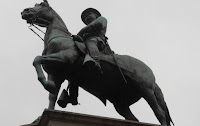In thinking of an image for today, Election Day, I thought of sites in Washington, DC, that might represent the stakes this country has faced and its best values. The usual buildings—the Capitol Dome, the Supreme Court, the Washington Monument—didn’t quite do it for me.
Then, in sorting through photos I took in November
2015 while on vacation, I was struck by this bronze equestrian statue at the
intersection of Pennsylvania Avenue and 7th St., N.W. From everything I’ve
read, sculptor Henry Jackson Ellicott captured the inspirational presence of
General Winfield Scott Hancock on the battlefield.
It has been over 30 years since I visited Gettysburg,
so I don’t recall the statue in his honor there. And I have never seen the bust
of him in New York’s Hancock Park, at St. Nicholas Avenue, Manhattan Avenue, and
West 123rd Street. But it’s hard for me to imagine a more uplifting tribute
than the one I saw in DC.
Have you ever heard of a more laudatory nickname than
“Hancock the Superb”? In Civil War battlefields stretching from the Peninsula
Campaign to the Siege of Petersburg, this career U.S. Army officer lived up to
his reputation. Brave but not rash, confident but not egocentric, he gave heart
to men with the deafening din of cannons and crack of rifles in their ears.
If you’ve seen the epic 1993 movie Gettysburg
or read the Pulitzer Prize-winning novel it was based on, The Killer Angels,
you might know of his part in that pivotal battle of the war: how he scouted
out the terrain, prepared the “fishhook” defense of the Union Army, and rallied
his II Corps to make its crucial stand against Pickett’s Charge.
As that furious assault took place, Hancock was
wounded—badly enough that he had to recuperate for six months afterward—but he
remained on the field until victory was secured.
Cool-headed in victory, Hancock displayed equanimity
in defeat. In 1880, he was beaten decisively by another former Union general,
James Abram Garfield, in the Electoral College, but lost the popular vote by
only 7,000—the slimmest margin ever for an also-ran.
At least one candidate today might regard Hancock as a
“loser,” but he was unfazed by what others would perceive as heartbreaking. “It
has been a complete Waterloo for you,” his wife said the next morning in waking
him with the bad news. “That is all right,” he responded. “I can stand it.”
Hancock died five years later. In 1889, the
appropriation for the proposed DC statue in his honor—$50,000—was considered
steep for the time. But a grateful Congress thought the tribute worth it, and
allocated the sum.
Ulysses S. Grant gave a characteristically concise but
astute assessment of his corps commander in his Personal Memoirs:
“His name was never mentioned as having committed in
battle a blunder for which he was responsible. He was a man of very conspicuous
personal appearance. Tall, well-formed and, at the time of which I now write,
young and fresh-looking, he presented an appearance that would attract the
attention of an army as he passed. His genial disposition made him friends, and
his personal courage and his presence with his command in the thickest of the
fight won for him the confidence of troops serving under him. No matter how
hard the fight, the 2d corps always felt that their commander was looking after
them.”
Throughout most of American history, losing candidates
are often forgotten. This is one who should not be. It was because of him and service
personnel of similar fiber that you and I still have a country.

No comments:
Post a Comment